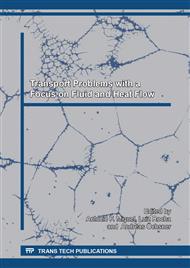p.124
p.133
p.140
p.149
p.157
p.166
p.171
p.181
p.189
Experimental Study of the Rate of Evaporation from Porous Media of Different Matrices
Abstract:
Evaporation and boiling from porous media has drawn a broad attention in many applications ranging from industrial, environmental to engineering and technologies. However, prediction of evaporation rates from porous media remains a challenge due to complex interactions between ambient conditions and the porous media properties such as complex geometry, material of the matrices composing porous medium, many length scales, surface phenomena, and effective transport coefficients. In this study, the evaporation rates of distilled water from porous media of different matrices were studied experimentally. Porous media were made up from spherical brass balls of different diameters of 2 mm, 3 mm, 4 mm and 5 mm. The temperature profiles across porous media, air temperature, humidity, and amount of water evaporated were measured in experiments. The effects of the porosity, the thickness of a porous layer, and particle size on the evaporation from porous media were investigated. Different materials of the porous matrices have allowed bringing to light the influence of the material properties. The experimental data show that the rate of evaporation of distilled water with brass balls is higher than that of only distilled water without a porous medium embedded into the water layer and does not change significantly after a steady state condition is achieved.
Info:
Periodical:
Pages:
171-180
Citation:
Online since:
November 2017
Authors:
Keywords:
Price:
Сopyright:
© 2017 Trans Tech Publications Ltd. All Rights Reserved
Share:
Citation:


